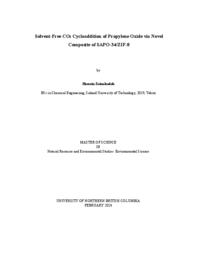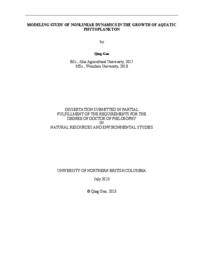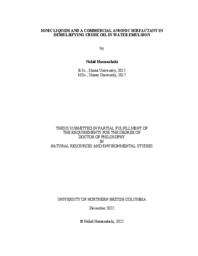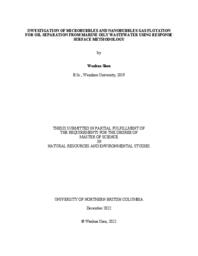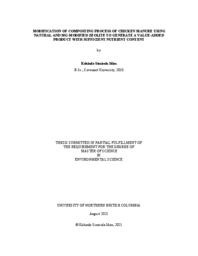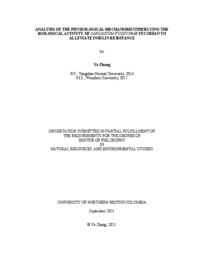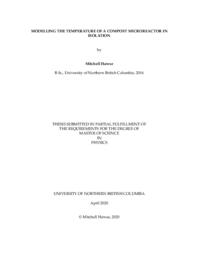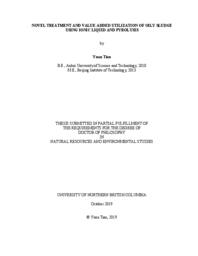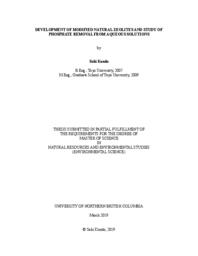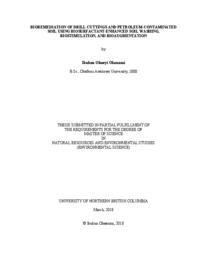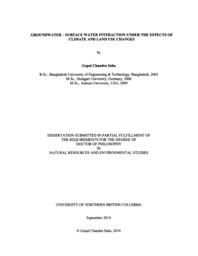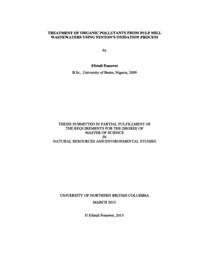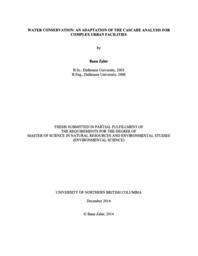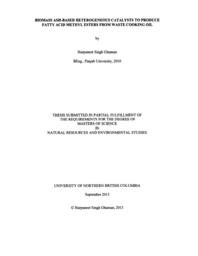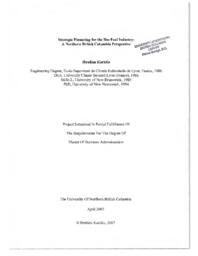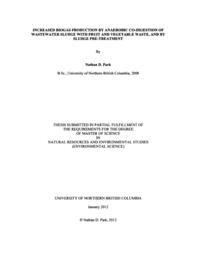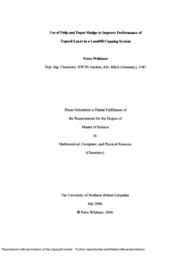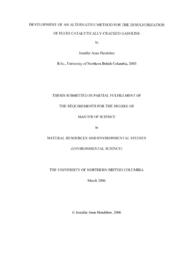Thring, Ronald Wallen
Person Preferred Name
Ronald Wallen Thring
Related Works
Content type
Digital Document
Description / Synopsis
In this research, ZIF-8/SAPO-34 composites with various wt.% of ZIF-8 and SAPO-34 were prepared and used as catalysts to synthesize cyclic carbonate solventless from CO2 and propylene oxide. Among composites, SAPO-34/ZIF-8 75:25 wt.% (S/Z25) had the highest conversion value of 92.59%, confirmed by 1HNMR analysis. Various physicochemical techniques were used to characterize the optimized composite, including X-ray diffraction (XRD), SEM, FT-IR, and BET. The impact of different reaction parameters such temperature, reaction time, CO2 pressure, and catalyst amount on the catalyst reactivity were studied. The highest conversion value has been obtained at 120 psi, 100 ℃, and 240 min. The conversion value was decreased by 20% when the catalyst loading value was changed from 0.4 to 0.1 g. Additionally, the catalyst's recyclability was confirmed for three runs without any significant changes in conversion. However, it was observed that after five repeated tests of reusability, the conversion percentage value decreased from 92.59% to 88.66%.
Origin Information
Content type
Digital Document
Description / Synopsis
Phytoplankton bloom has become a growing global concern in recent years due to the excessive growth of algae, causing significant negative impacts on aquatic ecosystem and threatening human health. Growing evidence suggests that algal blooms are a consequence of the interplay of various hydrodynamical, chemical, and biological processes in aquatic systems. The complexity and nonlinearity of aquatic ecosystems, and the complexity of climatic and hydrographic events, make interpreting and predicting the blooms a very challenging task. In recent years, many different strategies have been adopted to manage algal blooms. Among them, mathematical models are advantageous because they can capture the ubiquitous stoichiometric constraints for modeling species growth and interaction. Thus, mathematical models have been widely used to investigate the dynamics of phytoplankton growth. In this study, five mathematical models were developed based on population dynamics, ecological dynamics, dynamic modeling, and probability theory. The models were investigated theoretically and numerically in terms of the theory of partial differential equations, stochastic differential equations, impulsive differential equations, and numerical simulation. The objective of this dissertation research was to gain insight into plankton dynamics and explore potential management strategies for excessive algal growth in aquatic systems. The main results are presented as follows: Firstly, a nutrient-plankton model incorporating delay and diffusion was developed. The theoretical analysis revealed that delay can trigger the nutrient-plankton oscillation via a Hopf bifurcation. Especially, the stability switches for positive equilibrium occur with increasing delay, which indicates that delay can generate and suppress the unstable coexistence of species population. Numerical results reveal that the stability switches for positive equilibrium indeed exist in the model, and the homogeneous multiple periodic solutions, as well as chaos, can occur with different values of delay, which implies that the model exhibits delay-induced complex dynamics. Secondly, a stochastic Leslie-Gower phytoplankton-zooplankton model with prey refuge was developed. The dynamical analysis revealed the sufficient conditions for the persistence and extinction of plankton populations. The numerical simulations showed that environmental noise and prey refuge play a crucial role in the survival of plankton species. The results further demonstrate that prey refuge can enhance the oscillation range of phytoplankton population, but the variance of zooplankton tends to increase and then decrease as prey refuge increased. Thirdly, considering seasonal disturbances in aquatic ecosystem, a stochastic nutrient-phytoplankton model with seasonal fluctuation was developed. The results indicate that periodic solutions exist under certain conditions, suggesting that plankton populations are associated with periodic oscillations. Furthermore, numerical results showed that seasonal fluctuation can trigger periodic blooms of phytoplankton and promote the coexistence of plankton species. Specifically, the results indicate that phytoplankton is more sensitive to nutrient than to seasonal fluctuation. Fourthly, a stochastic nutrient-plankton model with regime-switching was developed by considering regime-switching plankton mortality. The results showed that the model admits a stationary distribution under certain conditions. Then the numerical analysis revealed that the persistence and extinction of plankton populations are sensitive to variations in nutrient input. The numerical results also indicate that regime-switching plankton mortality contributes to the survival of plankton populations in the aquatic system. Finally, a stochastic nutrient-plankton model with impulsive control was developed. The theoretical analysis established sufficient conditions for the existence of periodic solutions. In addition, the numerical analysis showed that nutrient impulse plays an important role in preventing and controlling algal blooms, and appropriate environmental fluctuation can promote the coexistence of phytoplankton and zooplankton populations. However, excess intensity noise can result in the collapse of the entire ecosystem.
Origin Information
Content type
Digital Document
Description / Synopsis
Crude oily wastewaters generate widely in industries and marine oil spill operations. Crude oily wastewaters contain stable oil in water emulsion (O/W), and their treatment has been challenging. Crude oil has toxic compounds for humans and the environment, and effective treatment requires meeting environmental regulations. This dissertation aimed to investigate effective and environmentally friendly demulsifiers (commercial anionic surfactant and ionic liquids) in demulsifying stable O/W emulsions. Firstly, the O/W emulsification process by ultrasonic homogenization was conducted to optimize the processing parameters and determine the required energy to generate stable emulsion, which is applicable for enhancing crude oil demulsification. The optimum condition to generate stable emulsion was at a power level of 76–80 W, sonication time of 16 min, water salinity of 15 g/L NaCl, and pH of 8.3, which required 60−70 kJ energy. Secondly, the commercial anionic surfactant showed high efficiency (99%) in demulsifying O/W emulsion at the concentration of 900 mg/L in a short shaking time (15 min) at room temperature (25 °C). It could reduce the total extractable petroleum hydrocarbons in the separated water to <10 mg/L without gravity separation and achieve promising demulsification performance at high salinity (36 g/L) and various fresh and weathered oil concentrations. Thirdly, ionic liquid with hydroxyl functional groups on the side chains effectively demulsified O/W emulsion (92%) stabilized by natural emulsifiers (e.g., asphaltenes) at a low concentration (25 mg/L) and room temperature without settling. Hence, the hydroxyl functional group is a suitable substitution for the alkyl group on the ionic liquids side chains to reduce ionic liquid toxicity. It was also found that its potency was highly affected by the emulsion type (stabilized by natural emulsifiers+Tween 20), in which demulsification efficiency reached 61% at the ionic liquid concentration of 50 mg/L and the demulsification temperature of 50 °C at 90 min gravity separation settling time. This indicated the synergistic interaction of natural emulsifiers and Tween 20 and the formation of thicker film at the oilwater interface, which affected the ionic liquid performance. Finally, comparing the performance of three ammonium-based ionic liquids with a distinct side chain (alkyl, ester, and amide) in demulsifying O/W emulsion, it was found that ionic liquid’s side chain and hydrophilicity greatly influenced their performance in the demulsifying O/W emulsion. Substitution of the hydrophobic alkyl group with the hydrophilic amide or ester groups to reduce ionic liquid toxicity improved the ionic liquid potency in the demulsifying emulsion. Ionic liquid with the amide group on the side chain resulted in the highest demulsification efficiency (94%) compared to ionic liquids with the ester (91%) and alkyl (88%) groups at the ionic liquid concentration of 25 mg/L and settling time of 15 min at room temperature, indicating the superiority of the amide group in the demulsifying O/W emulsion.
Origin Information
Content type
Digital Document
Description / Synopsis
Oily wastewater caused by marine oil spills brings great harm to the environment. In this work, the application of gas flotation with microbubbles and nanobubbles in separating crude oil droplets from oily wastewater is reported. The experiments were conducted in a flotation column with an internal diameter of 5.2 cm and a height of 100 cm. Response surface methodology was employed to examine the effects of three experimental factors (initial oil concentration, flotation time, and temperature of inlet wastewater) on the oil separation performance and the interaction between experimental factors. A good agreement was obtained between the predicted and experimental data of oil separation efficiency, with a high R2 of 0.99 and an adjusted R2 of 0.98. The optimization results demonstrate that the maximum oil separation efficiency (98.3%) was achieved under optimum experimental conditions of 524.5 mg/L initial oil concentration, 28.6 min flotation time, and 21.2°C inlet wastewater temperature.
Origin Information
Content type
Digital Document
Description / Synopsis
It is well known that the density of plankton populations always increases and decreases or keeps invariant for a long time, and the variation of plankton density is an important factor influencing the real aquatic environments, why do these situations occur? It is an interesting topic which has become the common interest for many researchers. As the basis of the food webs in oceans, lakes, and reservoirs, plankton plays a significant role in the material circulation and energy flow for real aquatic ecosystems that have a great effect on the economic and social values. Planktonic blooms can occur in some environments, however, and the direct or indirect adverse effects of planktonic blooms on real aquatic ecosystems, such as water quality, water landscape, aquaculture development, are sometimes catastrophic, and thus planktonic blooms have become a challenging and intractable problem worldwide in recent years. Therefore, to understand these effects so that some necessary measures can be taken, it is important and meaningful to investigate the dynamic growth mechanism of plankton and reveal the dynamics mechanisms of formation and disappearance of planktonic blooms. To this end, based on the background of the ecological environments in the subtropical lakes and reservoirs, this dissertation research takes mainly the planktonic algae as the research objective to model the mechanisms of plankton growth and evolution. In this dissertation, some theories related to population dynamics, impulsive control dynamics, stochastic dynamics, as well as the methods of dynamic modeling, dynamic analysis and experimental simulation, are applied to reveal the effects of some key biological factors on the dynamics mechanisms of the spatial-temporal distribution of plankton and the termination of planktonic blooms, and to predict the dynamics evolutionary processes of plankton growth. The main results are as follows: Firstly, to discuss the prevention and control strategies on planktonic blooms, an impulsive reaction-diffusion hybrid system was developed. On the one hand, the dynamic analysis showed that impulsive control can significantly influence the dynamics of the system, including the ultimate boundedness, extinction, permanence, and the existence and uniqueness of positive periodic solution of the system. On the other hand, some experimental simulations were preformed to reveal that impulsive control can lead to the extinction and permanence of population directly. More precisely, the prey and intermediate predator populations can coexist at any time and location of their inhabited domain, while the top predator population undergoes extinction when the impulsive control parameter exceeds some a critical value, which can provide some key arguments to control population survival by means of some reaction-diffusion impulsive hybrid systems in the real life. Additionally, a heterogeneous environment can affect the spatial distribution of plankton and change the temporal-spatial oscillation of plankton distribution. All results are expected to be helpful in the study of dynamic complex of ecosystems. Secondly, a stochastic phytoplankton-zooplankton system with toxic phytoplankton was proposed and the effects of environmental stochasticity and toxin-producing phytoplankton (TPP) on the dynamics mechanisms of the termination of planktonic blooms were discussed. The research illustrated that white noise can aggravate the stochastic oscillation of plankton density and a high-level intensity of white noise can accelerate the extinction of plankton and may be advantageous for the disappearance of harmful phytoplankton, which imply that the white noise can help control the biomass of plankton and provide a guide for the termination of planktonic blooms. Additionally, some experimental simulations were carried out to reveal that the increasing toxin liberation rate released by TPP can increase the survival chance of phytoplankton population and reduce the biomass of zooplankton population, but the combined effects of those two toxin liberation rates on the changes in plankton are stronger than that of controlling any one of the two TPP. All results suggest that both white noise and TPP can play an important role in controlling planktonic blooms. Thirdly, we established a stochastic phytoplankton-toxic producing phytoplankton-zooplankton system under regime switching and investigated how the white noise, regime switching and TPP affect the dynamics mechanisms of planktonic blooms. The dynamical analysis indicated that both white noise and toxins released by TPP are disadvantageous to the development of plankton and may increase the risk of plankton extinction. Also, a series of experimental simulations were carried out to verify the correctness of the dynamical analysis and further reveal the effects of the white noise, regime switching and TPP on the dynamics mechanisms of the termination of planktonic blooms. On the one hand, the numerical study revealed that the system can switch from one state to another due to regime shift, and further indicated that the regime switching can balance the different survival states of plankton density and decrease the risk of plankton extinction when the density of white noise are particularly weak. On the other hand, an increase in the toxin liberation rate can increase the survival chance of phytoplankton but reduce the biomass of zooplankton, which implies that the presence of toxic phytoplankton may have a positive effect on the termination of planktonic blooms. These results may provide some insightful understanding on the dynamics of phytoplankton-zooplankton systems in randomly disturbed aquatic environments. Finally, a stochastic non-autonomous phytoplankton-zooplankton system involving TPP and impulsive perturbations was studied, where the white noise, impulsive perturbations and TPP are incorporated into the system to simulate the natural aquatic ecological phenomena. The dynamical analysis revealed some key threshold conditions that ensure the existence and uniqueness of a global positive solution, plankton extinction and persistence in the mean. In particular, we determined if there is a positive periodic solution for the system when the toxin liberation rate reaches a critical value. Some experimental simulations also revealed that both white noise and impulsive control parameter can directly influence the plankton extinction and persistence in the mean. Significantly, enhancing the toxin liberation rate released by TPP increases the possibility of phytoplankton survival but reduces the zooplankton biomass. All these results can improve our understanding of the dynamics of complex of aquatic ecosystems in a fluctuating environment.
Origin Information
Content type
Digital Document
Description / Synopsis
In this study, an effective and low-cost water treatment system is developed. At first, an investigation combining published literature, available information through different health regions and raw water sample data from participating communities was done. Through that investigation, a critical water contamination problem, experienced by the rural, remote, First Nation communities was identified, which is Manganese. Then a treatment system was developed to effectively remove Manganese from the source water. Greensand plus was used as a filtration media and the prototype was designed to best suit the need of the community residents to remove Manganese in raw water. The lab scale and prototype experiments were designed using design expert software; adsorption isotherm and kinetics study were also conducted. The prototype was able to reach a removal efficiency 96.50% which can effectively treat source water levels found in the raw water sample. Therefore, a fit-for-purpose solution is developed to remove Manganese from raw water, which is cost effective, easy to use and maintain. Cost effectiveness is demonstrated through comparison of the developed system with available typical clean water supply strategies.
Origin Information
Content type
Digital Document
Description / Synopsis
This research was aimed at developing a composting process of organic waste using natural and modified zeolites by ascertaining how effective they were in retaining phosphorus (P) after 60 days. The experiments included compost (C) containing natural (N) and modified (M) zeolite (Z) treatments (applied at 10% and 15% on a weight basis of the total waste): CNZ10, CNZ15, CMZ10, CMZ15 and C (which is the control treatment with no zeolite addition). The second objective was to compare the barley shoot biomass and nutrient concentration of the various compost treatments mixed with soil and control treatment (just soil) after 45 days of planting in the greenhouse. In general, the benefits of co-addition of compost and zeolite on sandy soil were tested in a completely randomized experimental design. The results indicated that the treatments with the highest zeolite treatments (CNZ15 and CMZ15) proved most effective at retaining P by the end of the composting process (2.8mg and 2.9mg respectively) compared to the lower zeolite ratios and the control treatment; CNZ10 (2.0mg), CMZ10 (1.9mg) and C (0.7mg). The barley shoot biomass results indicated that the treatments that had a combination of soil (S) and modified zeolite (SCMZ10 and SCMZ15) had biomass of 7.67g and 7.24g respectively, followed by the natural zeolite and compost treatments (SCNZ10, SCNZ15 and SC) having 6.19g, 6.38g and 5.99g respectively and were significantly different from the control treatment (S) which had the lowest biomass of 0.48g. With respect to the plant nutrient concentration, N and P were significantly higher in the control treatment (S) compared to the other treatments while K concentration was significantly highest in the compost and some of the zeolite treatments (SC, SCNZ15 and SCMZ15) compared to other treatments. These results were in line with some previous findings where zeolite was used as a soil amendment in agriculture.
Origin Information
Content type
Digital Document
Description / Synopsis
Type 2 diabetes mellitus (T2DM) is a chronic metabolic disease characterized by hyperglycemia resulting from progressive loss of β-cell insulin secretion frequently on the background of insulin resistance. T2DM, also known as non-insulin-dependent diabetes, accounts for more than 90% of all cases of diabetes. Insulin resistance (IR) refers to the reduced sensitivity of peripheral tissues to insulin and is one of the important triggers of type 2 diabetes. Sargassum fusiforme polysaccharide exhibits diverse biological activities, and more and more studies have shown it has a significant effect in improving insulin resistance with almost no side effects. Sargassum fusiforme fucoidan (SFF) is one of the main active components with active ingredients such as antioxidants and hypoglycemic lipids. However, the ameliorative effects of SFF on high-fat diet-induced insulin resistance mice and its underlying physiological mechanisms are not clear. Hence, the polysaccharides were extracted and purified from Sargassum fusiforme, and fucoidan (SFF), which has good antioxidant activity, was screened using a drosophila melanogaster aging model. The effect of SFF on the amelioration of insulin resistance in mice was investigated with a high-fat obese insulin resistance mice model. By gut microbiota and metabolomics techniques, the effect of SFF on intestinal metabolites and its mechanism of alleviate IR were investigated. After treatment with 200 mg/kg SFF for 8 weeks, it was found that SFF could reduce body weight, fasting blood glucose and homa-IR in insulin resistance mice. SFF could effectively activate Nrf2/ARE antioxidant signaling pathway in the liver and promote Nrf2 entry into the nucleus and downstream gene transcription. Metabolomics and intestinal microecology revealed that SFF could upregulate TUDCA level and downregulate ceramide level in mice colon and serum, and this change was dependent on gut microbiota. TUDCA effectively inhibits the FXR/SHP signaling pathway activated by a high-fat diet, thereby reducing the biosynthesis of enteric-derived ceramides. In addition, TUDCA in the liver could compete with Nrf2 to bind Keap1 to reduce the formation of the Nrf2/Keap1 complex, reduce Nrf2 ubiquitination, and thus contribute to Nrf2/ARE signaling activation. In conclusion, fucoidan from S. fusiforme was able to modulate gut microbiota, increased the levels of the intestinal metabolite TUDCA, reduced biosynthesis of entericderived ceramides and activated the Nrf2/ARE pathway, which in turn significantly improved insulin resistance induced by high-fat diet in mice. This study provides a new research idea for the study of brown algae fucoidan in metabolic diseases.
Origin Information
Content type
Digital Document
Description / Synopsis
A mixture of waste-wood biomass and municipal biosolids waste was composted in a plastic container inside of an insulated chamber. The mixture of biomass and biosolids was approximately 50:50 and weighed 82.6 kg. The peak temperature of the compost was 32.4◦C. The small scale of the compost system allowed the lower limit of the compost decomposition rate to be studied. A model was successfully developed to predict the core temperature of the compost using the ambient temperature in the insulated chamber. A literature review was conducted to determine literature values for the overall convective and conductive heat transfer coefficient, the dry mass fraction, and heat of combustion for both biomass and biosolids. The model used an optimization algorithm to calculate the rate constant for the experimental setup. The calculated decomposition rate constant was 0.0525 Day−1.
Origin Information
Content type
Digital Document
Description / Synopsis
The effective treatment of oily sludge has been a challenging problem faced by the petroleum industry worldwide. It is a semi-solid mixture of hydrocarbons, water, metallic ions, and suspended fine solids. The recalcitrant nature of oily sludge makes the treatment a difficult and costly task. The objective of this dissertation research was to develop environmentally friendly and economically competitive techniques for oily sludge treatment. Three different approaches were developed: ionic liquid (IL)-enhanced solvent extraction, co-pyrolysis with wood waste, and value-added utilization of oily sludge as sorbent to remove lead (Pb2+) and cadmium (Cd2+) from solution. Firstly, as compared to conventional solvent extraction, the IL-enhanced solvent extraction not only improved oil recovery efficiency but also greatly reduced solvent and energy consumption as well as shortening the treatment duration even at low IL concentration. Secondly, co-pyrolysis of oily waste and hog fuel was conducted in a fixed bed reactor. Three experimental parameters (pyrolysis temperature, reaction time, and hog fuel addition) were explored to optimize both oil recovery and metal ion immobilization. The latter was tested through sequential extraction techniques with high temperature pyrolysis leading to metal ions fixed within the residues. The addition of hog fuel had a significant synergistic effect on the distribution of metal ions in the various extraction fractions resulting in lower risk index (RI) values. Thirdly, the oily sludge-derived char (OS500) obtained at 500 °C could effectively remove Pb2+ from solution with the maximum sorption capacity of 373.2 mg/g (based on a Langmuir model). Sorption of Pb2+ by the OS500 was mainly attributed to its precipitation with carbonate (CO32‒) originating in OS500. The maximum sorption capacity for Cd2+, using a Langmuir model, was 23.19 mg/g. Complexation and metal ion exchange dominated Cd2+ sorption on OS500. The Pb2+ sorption capacity dramatically decreased as the iii pyrolysis temperature increased from 500 to 900 °C due to the decomposition of minerals which could release CO32‒ at high temperature. The activated OS500 showed a higher sorption capacity (90.06 mg/g) for Cd2+ than OS500 (23.95 mg/g) because conversion of barite (BaSO4) to witherite (BaCO3) after chemical activation favored the precipitation of Cd-carbonate.
Origin Information
Content type
Digital Document
Origin Information
Content type
Digital Document
Origin Information
Content type
Digital Document
Origin Information
Content type
Digital Document
Origin Information
Content type
Digital Document
Origin Information
Content type
Digital Document
Origin Information
Content type
Digital Document
Origin Information
Content type
Digital Document
Origin Information
Content type
Digital Document
Origin Information
Content type
Digital Document
Origin Information
Content type
Digital Document
Origin Information
Content type
Digital Document
Origin Information
Content type
Digital Document
Origin Information
Content type
Digital Document
Origin Information
Content type
Digital Document
Origin Information

